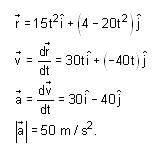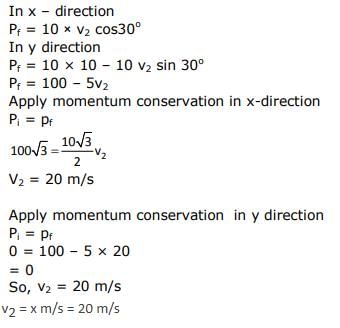PCM - Mock Test (May 31) - JEE MCQ
30 Questions MCQ Test - PCM - Mock Test (May 31)
A ball is thrown upward with an initial velocity V0 from the surface of the earth. The motion of the ball is affected by a drag force equal to m v2 (where m is mass of the ball, v is its instantaneous velocity and
v2 (where m is mass of the ball, v is its instantaneous velocity and  is a constant). Time taken by the ball to rise to its zenith is:
is a constant). Time taken by the ball to rise to its zenith is:
A particle is moving with speed v = b along positive x-axis. Calculate the speed of the particle at time t =
along positive x-axis. Calculate the speed of the particle at time t =  .
.
(Assume that the particle is at origin t = 0)
(Assume that the particle is at origin t = 0)
The trajectory of a projectile near the surface of the Earth is given as y = 2x - 9x2. If it was launched at an angle θ0 with speed v0, then
(g = 10 ms-2)
(g = 10 ms-2)
A particle moves in one dimension from rest under the influence of a force that varies with the distance travelled by the particle as shown in the figure. The kinetic energy of the particle after it has travelled 3 m is:
The position vector of a particle changes with time, according to the relation, . What is the magnitude of the acceleration at t = 1?
The velocity (v) and time (t) graph of a body in a straight line motion is shown in the figure. The point S is at 4.333 seconds. The total distance covered by the body in 6 s is
A small ball of mass m is thrown upward with velocity u from the ground. The ball experiences a resistive force mkv2, where v is its speed. The maximum height attained by the ball is:
A clock has a continuously moving second's hand of 0.1 m length. The average acceleration of the tip of the hand (in units of ms-2) is of the order of
A particle moves such that its position vector r(t) = cos ωt i + sin ωt j, where ω is a constant and t is time. Then which of the following statements is true for the velocity vector v(t) and acceleration vector a(t) of the particle?
Ship A is sailing towards north-east with velocity km/hr where
points east and
north. Ship B is at a distance of 80 km east and 150 km north of Ship A and is sailing towards west at 10 km/hr. A will be at minimum distance from B in:
When a car is at rest, its driver sees raindrops falling on it vertically. When driving the car with speed v, he sees that raindrops are coming at an angle 60° from the horizontal. On further increasing the speed of the car to (1 + β)v, this angle changes to 45°. The value of β is close to
A projectile is projected with velocity of 25 m/s at an angle θ with the horizontal. After t seconds its inclination with horizontal becomes zero. If R represents horizontal range of the projectile, the value of θ will be
[use g = 10 m/s2]
A modern grand-prix racing car of mass m is travelling on a flat track in a circular arc of radius R with a speed v. If the coefficient of static friction between the tyres and the track is μs, then the magnitude of negative lift FL acting downwards on the car is:
(Assume forces on the four tyres are identical and g = acceleration due to gravity)
A projectile is launched at an angle ' ' with the horizontal with a velocity 20 ms-1. After 10 s, its inclination with horizontal is '
' with the horizontal with a velocity 20 ms-1. After 10 s, its inclination with horizontal is ' '. The value of tan
'. The value of tan will be: (g = 10 ms-2)
Two projectiles are thrown with same initial velocity making an angle of 45° and 30° with the horizontal, respectively. The ratio of their respective ranges will be
A particle starts from the origin at t = 0 with an initial velocity of 3.0 m/s and moves in the x-y plane with a constant acceleration (6.0
+ 4.0
) m/s2. The x-coordinate of the particle at the instant when its y-coordinate is 32 m is D metres. The value of D is:
A particle moves such that its position vector r(t) = cos ωt i + sin ωt j, where ω is a constant and t is time. Then which of the following statements is true for the velocity vector v(t) and acceleration vector a(t) of the particle?
A girl standing on road holds her umbrella at 45° with the vertical to keep the rain away. If she starts running without umbrella with a speed of 15√2 kmh-1, the rain drops hit her head vertically. The speed of rain drops with respect to the moving girl is:
Motion of a particle in x-y plane is described by a set of following equations x = 4 sinm and y = 4 sin(
t) m. The path of particle will be
A person moved from A to B on a circular path as shown in figure. If the distance travelled by him is 60 m, then the magnitude of displacement would be: (Given cos135° = -0.7)
A circular disc of mass M and radius R is rotating about its axis with angular speed . If another stationary disc having radius R/2 and same mass M is dropped co-axially on to the rotating disc, gradually both discs attain constant angular speed
. The energy lost in the process is p% of the initial energy. Value of p is _____.
A ball of mass 10 kg moving with a velocity 10√3m/s along the x-axis, hits another ball of mass 20 kg which is at rest. After the collision, the first ball comes to rest while the second ball disintegrates into two equal pieces. One piece starts moving along the y-axis with a speed of 10 m/s. The second piece starts moving at an angle of 30° with respect to the x-axis. The velocity of the ball moving at 30° with x-axis is x m/s. The configuration of pieces after collision is shown in the figure below. The value of x to the nearest integer is ______.
If the initial velocity in horizontal direction of a projectile is unit vector and the equation of trajectory is y = 5x(1 - x), the y component vector of the initial velocity is _______
. (in integers)
(Take g = 10 m/s2)
A car is moving on a plane inclined at 30° to the horizontal with an acceleration of 10 ms-2 parallel to the plane upward. A bob is suspended by a string from the roof of the car. The angle (in degree) which the string makes with the vertical is __________. (in integers)
In the given figure, the angle of inclination of the inclined plane is 30°. Find the horizontal velocity V0 (in m/s) so that the particle hits the inclined plane perpendicularly. Given, H = 9 m, g = 10m/s2

Which of the following set of elements obeyes Newland’s octave rule -
Which of the following will not form crystalline structure with oppositely charged ions
Which is not anomalous pair of elements in the Medeleeves periodic table -
Elements in the same vertical group of the periodic table have same




 ... (2)
... (2) = cos-1
= cos-1 =
=  and
and 




 is perpendicular to
is perpendicular to  and
and  is directed towards the origin.
is directed towards the origin.




 = tan60° ... (i)
= tan60° ... (i) = tan45° ... (ii)
= tan45° ... (ii)
 and tan45° = 1
and tan45° = 1


 = 1.73 - 1 = 0.73 ... (Since
= 1.73 - 1 = 0.73 ... (Since  = 1.73)
= 1.73)


 is perpendicular to
is perpendicular to  and
and  is directed towards the origin.
is directed towards the origin.



 .
.


 + 30°) =
+ 30°) =  +
+  =
=  =
=  = 30°
= 30° ----- (1)
----- (1)












